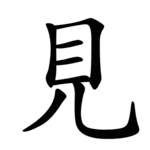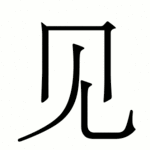| 見 | ||
|---|---|---|
| ||
| 見 (U+898B) "see" | ||
| Pronunciations | ||
| Pinyin: | jiàn | |
| Bopomofo: | ㄐㄧㄢˋ | |
| Wade–Giles: | chien4 | |
| Cantonese Yale: | gin3 | |
| Jyutping: | gin3, jin6 | |
| Japanese Kana: | ケン ken (on'yomi) み-る mi-ru (kun'yomi) | |
| Sino-Korean: | 견 gyeon | |
| Names | ||
| Chinese name(s): | (Side) 見字旁/见字旁 jiànzìpáng (Bottom) 見字底/见字底 jiànzìdǐ | |
| Japanese name(s): | 見/みる miru | |
| Hangul: | 볼 bol | |
| Stroke order animation | ||
 | ||

Radical 147, also known as radical see (見部), represents the meaning "see" and is one of the 20 Kangxi radicals (out of a total of 214 radicals) composed of 7 strokes.
In the Kangxi Dictionary, there are 161 characters (out of 49,030) that can be found under this radical.
The simplified form of the character 見 is written as 见 and is the 78th indexing component in the Table of Indexing Chinese Character Components primarily used in Simplified Chinese dictionaries published in mainland China. The traditional form 見 is listed as its associated indexing component. The simplified form of this radical character consists of 4 strokes.
Evolution
 Oracle bone script character
Oracle bone script character Bronze script character
Bronze script character Large seal script character
Large seal script character Small seal script character
Small seal script character
Derived characters
| Strokes | Characters (見) | Characters (见) |
|---|---|---|
| +0 | 見 | 见SC (=見) |
| +2 | 覌 (=觀) 覙 (=覶 / 診 -> 言) | 观SC (=觀) |
| +3 | 覍 覎 | 觃SC (=覎) |
| +4 | 規 覐 (=覺) 覑 覒 覓 覔 (=覓) | 规SC (=規) 觅SC (=覓) |
| +5 | 覕 覗 覘 覚JP (=覺) | 觇SC (=覘) 览SC (=覽) 觉SC (=覺) |
| +6 | 覛 覜 | 觊SC (=覬) |
| +7 | 覝 覞 覟 覠 覡 | 觋SC (=覡) |
| +8 | 覢 覣 覤 覥 | 觌SC (=覿) 觍 (=覥) |
| +9 | 覦 覧JP (=覽) 覨 覩 (=睹 -> 目) 親 | 觎SC (=覦) |
| +10 | 覫 覬 覭 覮 覯 | 觏SC (=覯) |
| +11 | 覰 覱 覲 観 (=觀) | 觐SC (=覲) 觑SC (=覷) |
| +12 | 覴 覵 覶 覷 覸 | |
| +13 | 覹 覺 覻 (=覰) | |
| +14 | 覼 (=覶) 覽 | |
| +15 | 覾 覿 | |
| +18 | 觀 |
Sinogram
As an independent sinogram It is one of the Kyōiku kanji or Kanji taught in elementary school in Japan.[1] It is a first grade kanji[1]
References
- 1 2 "The Kyoiku Kanji (教育漢字) - Kanshudo". www.kanshudo.com. Archived from the original on March 24, 2022. Retrieved 2023-05-06.
Further reading
- Fazzioli, Edoardo (1987). Chinese calligraphy : from pictograph to ideogram : the history of 214 essential Chinese/Japanese characters. calligraphy by Rebecca Hon Ko. New York: Abbeville Press. ISBN 0-89659-774-1.
- Lunde, Ken (Jan 5, 2009). "Appendix J: Japanese Character Sets" (PDF). CJKV Information Processing: Chinese, Japanese, Korean & Vietnamese Computing (Second ed.). Sebastopol, Calif.: O'Reilly Media. ISBN 978-0-596-51447-1.
See also
- Mimi and Mi